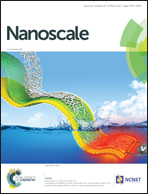Real-time dark-field light scattering imaging to monitor the coupling reaction with gold nanorods as an optical probe†
Abstract
Gold nanorods (GNRs) have opened up promising applications based on their reshaping, due to the fact that a tiny change in shape or size could directly lead to optical changes. Herein, we report chemical reshaping of GNRs induced by the coupling reaction between Au, ferric chloride and thiourea. In the coupling reaction, Fe3+ oxidizes the GNRs to yield Au(I), which complexes with the thiourea ligand, lowering the Gibbs free energy of the gold species and promoting the reaction equilibrium to enable the chemical reshaping of the GNRs. This coupling reaction process was monitored using a light-scattering dark-field microscopy (DFM) imaging technique and scanning electron microscopy (SEM). The light scattering underwent a colour change from bright red to yellow and finally to green, and the GNRs underwent a morphological change from rod-shaped to fusiform and finally to spherical, which is somewhat different from the results of other chemical etching processes of GNRs. It is believed that the coupling reaction induced chemical reshaping of GNRs not only provides an alternative way to monitor the coupling reaction, but also offers a facile way to obtain a desirable GNR morphology, which is important for the preparation of fusiform nanostructures.



 Please wait while we load your content...
Please wait while we load your content...